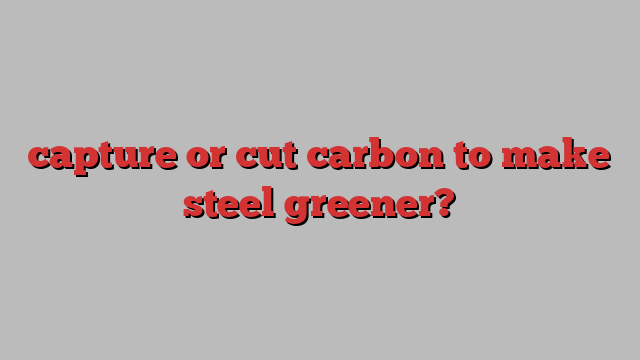
Unlock the Editor’s Digest for free
Roula Khalaf, Editor of the FT, selects her favourite stories in this weekly newsletter.
Iron ore + coal = iron + carbon dioxide. This chemical reaction, known long before the invention of the periodic table, is a key part of the steelmaking process and has helped build the modern world. But every tonne of iron generates more than two tonnes of CO₂, giving the iron and steel sector outsize importance in addressing climate change: it is responsible for one-tenth of global annual greenhouse gas emissions.
Greener methods are helping, such as recycling steel and producing iron in furnaces powered by natural gas, a somewhat cleaner fossil fuel than coal. Combined, they offer ways to reduce carbon emissions by as much as 70 per cent. These methods account for nearly a third of global steel production, with the remainder from coal-powered furnaces.
Limitations of greener methods in steel making
But they have limitations. Recycling is confined to areas with enough existing steel to use as scrap, which helps Europe more than Asia. The natural gas process requires higher-quality iron ore as an input, adding layers of complication and cost.
Another approach is to sequester the emissions rather than releasing them into the atmosphere using a technique called carbon capture, utilisation and storage (CCUS), which requires modifications to coal-powered plants. It could reduce emissions by as much as 90 per cent.
Test yourself
This is the eighth in a series of monthly business school-style teaching case studies devoted to responsible-business dilemmas. Read the text and FT articles suggested at the end (and linked to within the piece) before considering the questions raised.
About the author: Gernot Wagner is a climate economist at Columbia Business School.
The series forms part of a wide-ranging collection of FT ‘instant teaching case studies’ that explore business challenges.
But in countries that are not pursuing policies to penalise emissions, or are not subsidising the fitting of the scrubbing technology, installing CCUS in existing coal-fired blast furnaces is a costly modification. Moreover, while the technology might cut the amount of CO₂ produced, the blast furnaces would continue generating other forms of pollution, such as soot and black carbon, with associated health risks.
Other approaches to cutting emissions
Two approaches could slash emissions without handing a lifeline to coal. Stegra, the business formerly known as H2 Green Steel, uses the traditional steel making process but with green hydrogen as its fuel instead of natural gas. It is developing the world’s first commercial green steel plant in Boden, Sweden, just south of the Arctic Circle.
It pre-sold half its future production to companies including carmakers Mercedes-Benz and Porsche and plans to begin operating in 2026, producing around 2.5mn tonnes of steel a year, rising to 5mn by 2030. Other producers have followed with plans for 40mn tonnes of green steel production annually.
But only a limited quantity of green hydrogen — made using renewable energy to split water via electrolysis — is currently produced. So Stegra is making the fuel itself using local cheap renewable energy. The steel is more expensive than the coal-based variety but is also higher quality, for which European carmakers appear willing to pay a premium. The technique could cut carbon emissions by around 90 per cent.
While Stegra deploys a variant of traditional steelmaking, others are trying more creative techniques using iron ore electrolysis. This extracts iron by using either acid, a process known as electrowinning, or an electric current, known as molten oxide electrolysis.
Climate Capital

Where climate change meets business, markets and politics. Explore the FT’s coverage here.
Are you curious about the FT’s environmental sustainability commitments? Find out more about our science-based targets here
This second method is being tested by Electra, based in the US state of Colorado. It is working on purifying iron ore at more moderate temperatures than traditional processes, which would permit more intermittent iron production and could run directly on renewable energy, lowering costs. Indeed, the process could be reversed, releasing electricity like a solid-state battery as iron is converted back into iron ore.
Iron ore electrolysis could reduce carbon emissions by as much as 97 per cent over the traditional coal approach. The process may also broaden the range of materials that can be processed into iron — using materials that were previously considered waste: “stranded” ore too dirty to be used in blast furnaces.
But the economics remain speculative. Electra says it can produce iron at around $215 per tonne, which excludes both the price of raw materials (stranded ore might even be available for free) and the cost of converting it into steel. This compares to an average cost of around $400 per tonne for producing crude steel in a coal-fired blast furnace or as much as $800 using green hydrogen.
Electra aims to establish commercial production by the end of this decade, with an initial production of around 300,000 tonnes a year.
Conclusion
Greening iron and steel production means grappling with broader questions around climate change and decarbonisation. Companies can either add on new technological layers to traditional processes or explore emerging technologies with the potential to scale up, at a cost.
The alternative is research and development into risky, earlier-stage approaches. Figuring out the right mix is key, and will require industry, financiers and governments to find the right balance.
Questions for discussion
Read:
Steelmakers look to hydrogen to green heavily polluting sector (ft.com)
Climate tech explained: low-emission steel plants (ft.com)
Decarbonizing steel (Columbia Business School)
Stegra: Green Hydrogen Steel (Columbia Business School)
Electra: Decarbonizing steelmaking through carbon-free iron (Columbia Business School)
Consider these questions:
-
Stegra was able to finance its first plant because of cheap low-carbon electricity, and offtake agreements from potential customers willing to pay a green premium. What are the prospects of replicating this business model elsewhere? What are some potential pitfalls? What are the necessary policy drivers?
-
You’re an investor seeking a balanced approach to decarbonisation. How do you split $100mn across CCUS, green hydrogen-based steel, and iron ore electrolysis? If you can invest in only one, which would you choose? Why?
-
How should established steelmakers respond? Which technologies are most compatible with their capabilities and expertise? Should these businesses invest in green steel even if it means cannibalising their existing business?